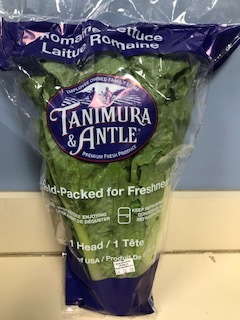
LANSING, Mich. – The Michigan Department of Agriculture and Rural Development (MDARD) is advising consumers not to eat Tanimura & Antle brand romaine lettuce packed as single heads due to food safety concerns.
A routine sample of the lettuce collected at a Walmart in Comstock Park, MI, and tested by MDARD’s Laboratory Division confirmed positive for E. coli 0157:H7. Further analysis conducted by the Michigan Department of Health and Human Services laboratory determined that the strain of E. coli recovered from the product sample is highly related genetically to E. coli causing two recent illnesses in Michigan.
The lettuce was sold in a zip-top clear plastic bag with a blue label and white lettering. It has the UPC number 0-27918-20314-9 and a white sticker indicating it was packed in Salinas, California on October 15, 2020.
Consumers should discard this product or return it to the place of purchase. If you think you or a family member have become ill from consuming any of these products, please seek immediate medical attention.
E. coli can cause serious or life-threatening illness in some individuals. Symptoms of Shiga toxin-producing E. coli (STEC) infection vary for each person, but often include severe stomach cramps, diarrhea (often bloody), and vomiting. Some people may have a fever, which usually is not very high (less than 101˚F/38.5˚C). Most people get better within 5 to 7 days. Some infections are very mild, but others are severe or even life-threatening. People usually get sick from Shiga toxin-producing
E. coli (STEC) 2 to 8 days (average of 3 to 4 days) after ingesting the bacteria. Some people with a STEC infection may get a type of kidney failure called hemolytic uremic syndrome (HUS).
E. coli infection is usually diagnosed by testing a stool sample.
###
Photo: Tanimura & Antle romaine lettuce
|